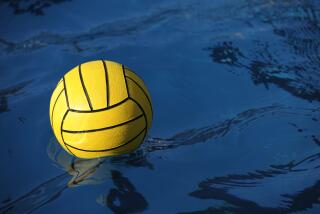Former El Segundo High Coach Saari Was an Innovator in Water Polo
- Share via
“Ask not for victory, ask only for courage. In your pursuit, you bring honor to yourself. But, more important, you bring honor to us all. We all share in Saari’s honor.”
--Jim Norris
A few years ago the book “Urho Saari Olympian” crossed my desk. Written by Jim and Lynne Norris, it chronicles the life of Saari, the legendary El Segundo High water polo and swimming coach who died Dec. 29 of Alzheimer’s disease at age 78.
Norris, who swam and played water polo for Saari at El Segundo, and his wife--through painstaking research--used newspaper clippings, interviews and school records to create a fascinating overview of Saari’s accomplishments, which were lengthy, to say the least.
Saari helped put the sleepy town of El Segundo on the map by putting many of the city’s youth in the pool. From the late 1940s to the mid-’60s, the high school gained a reputation for excellence in aquatic sports, in much the same way El Segundo has become known as a baseball school in the last three decades under Coach John Stevenson, another tow-headed icon.
A member of the water polo and swimming hall of fames, Saari coached El Segundo to 18 CIF championships--12 in water polo and six in swimming--during a 36-year career that began in 1942. He retired in 1973, only to return to coaching for four more years.
He initiated the city’s swimming program in 1942, and 18 of his athletes represented the United States 34 times in swimming and water polo competition in the Olympics and Pan American Games. His eldest son, Roy, won a gold medal and helped set a world record in the 800-meter freestyle relay at the 1964 Olympics in Tokyo.
Saari himself was the U.S. water polo coach in the 1951 Pan American Games and the 1952 and ’64 Olympics. He was manager of the 1960 Olympic team.
Known as an innovator in water polo, Saari insisted that more emphasis should be placed on swimming, rapid ball-handling and changes in offensive and defensive tactics. He frowned on rough play and thought that teams should be less dependent on scoring done by the center-forward or “hole man.”
Perhaps the most remarkable fact about Saari is that he touched so many people’s lives. Norris, in his book, wrote that Saari and his staff taught swim instruction to about “8,500 individuals” from 1943-73 at El Segundo High. At one time, Saari was credited with having coached more than one-third of the permanent lifeguard staff of the L.A. County Department of Beaches.
“Urho’s accomplishments (were) a tribute to him and to the city of El Segundo, which supported him by providing marvelous opportunities for the local youngsters,” Norris wrote. “Over 100 families--brothers, sisters and parent-child combinations--participated in Saari’s programs.”
In return, the city paid tribute to Saari by proclaiming May 24, 1973, as Urho Saari Day, which was marked by El Segundo High’s renaming of its pool in his honor.
Sadly, Saari’s final years were marred by a lengthy bout with Alzheimer’s disease. In the dedication of his book, Norris regrets not writing “20 years earlier, before Saari was zapped by Alzheimer’s.”
But, as Norris pointed out, the memories live on:
“Playing water polo under Coach Saari led to experiences about which most men fantasize. Playing water polo also introduced me to a self I could never have met. Every game was a roller-coaster ride, and my feelings covered a splendid range--exhaustion, fear, wonder, boredom, admiration, elation, anger, disappointment, idolatry. . .
“All of us grew under Saari’s quiet presence, proving ourselves time and time again. We came to know and accept ourselves and one another.”
Following are other excerpts from Norris’ book:
“His players always conducted themselves like gentlemen and kept the game in proper perspective. I played against Urho’s teams from 1950 through 1954 and it was always clear that he did much more for his ‘boys’ than just coach them at playing water polo. The title of coach is really not large enough for a man like Urho Saari.”
--Frank O’Conner, competitor, Illinois Athletic Club
“In August, 1965, while watching a swimming race, I turned and said ‘How is that young man ever going to make it as a butterfly swimmer with that form?’ (Saari) replied, ‘They will adjust his form and Mark Spitz will make it.’ ”
--Dr. Joseph M. Faust, manager, 1965 U.S. Maccabiah water polo team
“I’ll never forget the time Whitey (Saari) chewed me out, rightfully so, because I quit in the middle of a race. I just didn’t have the confidence to keep going. Whenever I get a little discouraged, I think of that occasion and that gives me the determination I need to keep in the middle of the race.”
--Cliff Crafton, El Segundo Class of ’53
“I’ll always remember your words of encouragement: ‘Work hard and your dreams will come true.’ ”
--Pat McCormick, Olympic diving champion
“My dad’s record shows an ability to develop outstanding competitors out of almost anyone with the desire and willingness to work. This is demonstrated by the El Segundo B and C teams that did not have exceptional seasons. As varsity team members, these same players were CIF champions.”
--Bob Saari, El Segundo Class of ’65 and three-time CIF water polo player of the year
“At the 1952 Olympics in Helsinki we had a hard time concentrating on our workout when we went to that seaside outdoor pool and noticed--when we peered out of the makeshift locker room at the end of the pier--that on the opposite side from us were at least 300 nude women . . . Whitey (Saari) had to really keep his charges in line and practice was obviously disrupted and cut short. He never did allow us to swim over to the other side--much to our disappointment.”
--Ace Burns, 1952 Olympic team, USC Class of ’52
“Had Saari been able to attend the 1984 Olympics, I am sure he would have felt deja vu, for there was the hole man--with play depending upon the foul--a return to the game he thought (hoped) had disappeared after 1948.”
--Jim Norris, El Segundo Class of ’48
Born to Finnish immigrants, Saari was raised in Buffalo, N.Y., and came to California in 1939 for graduate studies at UCLA.
After obtaining a degree in physical education, Saari received a call from the California Teachers Assn. regarding a position with the El Segundo school district.
“I had to take out a map to see where El Segundo was,” Saari recalled in Norris’ book. “It was isolated from everyone; hidden behind a wall of sand dunes. There were no signs to tell us where it was located. The city was small and looked like a movie set, and the high school stood out like a castle.”
El Segundo, which had about 4,000 residents at the time, had just built a municipal pool and was looking for someone to set up a swimming program. The city found its man in Saari.
“We got the backing of the community right from the start,” Saari said. “And as things were established, they were right there with us.”
More to Read
Get our high school sports newsletter
Prep Rally is devoted to the SoCal high school sports experience, bringing you scores, stories and a behind-the-scenes look at what makes prep sports so popular.
You may occasionally receive promotional content from the Los Angeles Times.






